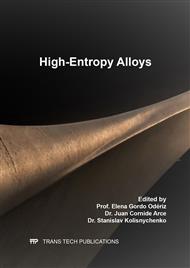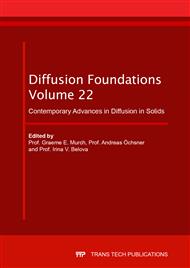[1]
K.-Y. Tsai, M.-H. Tsai, and J.-W. Yeh, Sluggish diffusion in Co–Cr–Fe–Mn–Ni high-entropy alloys, Acta Materialia, vol. 61, no. 13, pp.4887-4897, (2013).
DOI: 10.1016/j.actamat.2013.04.058
Google Scholar
[2]
J. Dąbrowa, W. Kucza, G. Cieślak, T. Kulik, M. Danielewski, and J.-W. Yeh, Interdiffusion in the FCC-structured Al-Co-Cr-Fe-Ni high entropy alloys: experimental studies and numerical simulations, Journal of Alloys and Compounds, vol. 674, pp.455-462, (2016).
DOI: 10.1016/j.jallcom.2016.03.046
Google Scholar
[3]
W.-H. Wu, C.-C. Yang, and L. Yeh, Industrial development of high-entropy alloys, in Annales De Chimie-Science Des Materiaux, 2006, vol. 31, no. 6, p.737: Paris; New York: Masson, (1978).
DOI: 10.3166/acsm.31.737-747
Google Scholar
[4]
S. Chikumba and V. V. Rao, High Entropy Alloys: Development and Applications, in 7th Int. Conf. Latest Trends Eng. Technol, pp.1-5, (2015).
Google Scholar
[5]
K.-H. Huang and J. Yeh, A study on the multicomponent alloy systems containing equal-mole elements, Hsinchu: National Tsing Hua University, (1996).
Google Scholar
[6]
Y. Zhang, T. T. Zuo, Zhi Tang, M. C. Gao, K. A. Dahmen, P. K. Liaw and Z. P. Lu, Microstructures and properties of high-entropy alloys, Progress in Materials Science, vol. 61, pp.1-93, (2014).
DOI: 10.1016/j.pmatsci.2013.10.001
Google Scholar
[7]
J. W. Yeh, S. K. Chen, S. J. Lin, J. Y. Gan, T. S. Chin, T. T. Shun, C. H. Tsau and S. Y. Chang, Nanostructured high‐entropy alloys with multiple principal elements: novel alloy design concepts and outcomes, Advanced Engineering Materials, vol. 6, no. 5, pp.299-303, (2004).
DOI: 10.1002/adem.200300567
Google Scholar
[8]
B. Cantor, I. Chang, P. Knight, and A. Vincent, Microstructural development in equiatomic multicomponent alloys, Materials Science and Engineering: A, vol. 375, pp.213-218, (2004).
DOI: 10.1016/j.msea.2003.10.257
Google Scholar
[9]
D. B. Miracle, J. D. Miller, O. N. Senkov, C. Woodward, M. D. Uchic, and J. Tiley, Exploration and development of high entropy alloys for structural applications, Entropy, vol. 16, no. 1, pp.494-525, (2014).
DOI: 10.3390/e16010494
Google Scholar
[10]
M.-H. Tsai and J.-W. Yeh, High-entropy alloys: a critical review, Materials Research Letters, vol. 2, no. 3, pp.107-123, (2014).
Google Scholar
[11]
Z. Lu, H. Wang, M. W. Chen, I. Baker, J. W. Yeh, C. T. Liu and T. G. Nieh, An assessment on the future development of high-entropy alloys: summary from a recent workshop, Intermetallics, vol. 66, pp.67-76, (2015).
DOI: 10.1016/j.intermet.2015.06.021
Google Scholar
[12]
S. J. Mary, N. Rajan, and R. Epshiba, High entropy alloys properties and its applications–An over view, European Chemical Bulletin, vol. 4, no. 4-6, pp.279-284, (2015).
Google Scholar
[13]
C. Tong, M. Chen, S. Chen, J. Yeh, T. Shun, S. Lin and S. Chang, Mechanical performance of the AlxCoCrCuFeNi high-entropy alloy system with multiprincipal elements metal, Mater Trans A, vol. 36, pp.881-893, (2005).
DOI: 10.1007/s11661-005-0283-0
Google Scholar
[14]
Y. Zhou, Y. Zhang, Y. Wang, and G. Chen, Solid solution alloys of Al Co Cr Fe Ni Ti x with excellent room-temperature mechanical properties, Applied physics letters, vol. 90, no. 18, p.181904, (2007).
DOI: 10.1063/1.2734517
Google Scholar
[15]
C.-Y. Hsu, C.-C. Juan, W.-R. Wang, T.-S. Sheu, J.-W. Yeh, and S.-K. Chen, On the superior hot hardness and softening resistance of AlCoCrxFeMo0. 5Ni high-entropy alloys, Materials Science and Engineering: A, vol. 528, no. 10-11, pp.3581-3588, (2011).
DOI: 10.1016/j.msea.2011.01.072
Google Scholar
[16]
M.-H. Tsai, C.-W. Wang, C.-W. Tsai, W.-J. Shen, J.-W. Yeh, J.-Y. Gan and W.-W. Wu, Thermal stability and performance of NbSiTaTiZr high-entropy alloy barrier for copper metallization, Journal of the Electrochemical Society, vol. 158, no. 11, pp. H1161-H1165, (2011).
DOI: 10.1149/2.056111jes
Google Scholar
[17]
Y.-F. Kao, T.-D. Lee, S.-K. Chen, and Y.-S. Chang, Electrochemical passive properties of AlxCoCrFeNi (x= 0, 0.25, 0.50, 1.00) alloys in sulfuric acids, Corrosion Science, vol. 52, no. 3, pp.1026-1034, (2010).
DOI: 10.1016/j.corsci.2009.11.028
Google Scholar
[18]
D. Miracle and O. Senkov, A critical review of high entropy alloys and related concepts, Acta Materialia, vol. 122, pp.448-511, (2017).
DOI: 10.1016/j.actamat.2016.08.081
Google Scholar
[19]
Y. Jien-Wei, Recent progress in high entropy alloys, Ann. Chim. Sci. Mat, vol. 31, no. 6, pp.633-648, (2006).
DOI: 10.3166/acsm.31.633-648
Google Scholar
[20]
J.-W. Yeh, Alloy design strategies and future trends in high-entropy alloys, Jom, vol. 65, no. 12, pp.1759-1771, (2013).
DOI: 10.1007/s11837-013-0761-6
Google Scholar
[21]
S. V. Divinski, A. Pokoev, N. Esakkiraja, and A. Paul, A mystery of sluggish diffusion" in high-entropy alloys: the truth or a myth,, arXiv preprint arXiv:1804.03465, (2018).
DOI: 10.4028/www.scientific.net/df.17.69
Google Scholar
[22]
M. Vaidya, S. Trubel, B. Murty, G. Wilde, and S. V. Divinski, Ni tracer diffusion in CoCrFeNi and CoCrFeMnNi high entropy alloys, Journal of Alloys and Compounds, vol. 688, pp.994-1001, (2016).
DOI: 10.1016/j.jallcom.2016.07.239
Google Scholar
[23]
M. Vaidya, K. Pradeep, B. Murty, G. Wilde, and S. Divinski, Radioactive isotopes reveal a non sluggish kinetics of grain boundary diffusion in high entropy alloys, Scientific reports, vol. 7, no. 1, p.12293, (2017).
DOI: 10.1038/s41598-017-12551-9
Google Scholar
[24]
M. Vaidya, K. Pradeep, B. Murty, G. Wilde, and S. Divinski, Bulk tracer diffusion in CoCrFeNi and CoCrFeMnNi high entropy alloys, Acta Materialia, vol. 146, pp.211-224, (2018).
DOI: 10.1016/j.actamat.2017.12.052
Google Scholar
[25]
D. Gaertner, J. Kottke, G. Wilde, S. V. Divinski, and Y. Chumlyakov, Tracer diffusion in single crystalline CoCrFeNi and CoCrFeMnNi high entropy alloys, Journal of Materials Research, pp.1-8, (2018).
DOI: 10.1557/jmr.2018.162
Google Scholar
[26]
W. Kucza, J. Dąbrowa, G. Cieślak, K. Berent, T. Kulik, and M. Danielewski, Studies of sluggish diffusion, effect in Co-Cr-Fe-Mn-Ni, Co-Cr-Fe-Ni and Co-Fe-Mn-Ni high entropy alloys; determination of tracer diffusivities by combinatorial approach, Journal of Alloys and Compounds, vol. 731, pp.920-928, (2018).
DOI: 10.1016/j.jallcom.2017.10.108
Google Scholar
[27]
Q. Li, W. Chen, J. Zhong, L. Zhang, Q. Chen, and Z.-K. Liu, On Sluggish Diffusion in Fcc Al–Co–Cr–Fe–Ni High-Entropy Alloys: An Experimental and Numerical Study, Metals, vol. 8, no. 1, p.16, (2017).
DOI: 10.3390/met8010016
Google Scholar
[28]
K. Jin, C. Zhang, F. Zhang, and H. Bei, Influence of compositional complexity on interdiffusion in Ni-containing concentrated solid-solution alloys, Materials Research Letters, vol. 6, no. 5, pp.293-299, (2018).
DOI: 10.1080/21663831.2018.1446466
Google Scholar
[29]
D. Beke and G. Erdélyi, On the diffusion in high-entropy alloys, Materials Letters, vol. 164, pp.111-113, (2016).
DOI: 10.1016/j.matlet.2015.09.028
Google Scholar
[30]
C. Zhang, F. Zhang, K. Jin, H. Bei, S. Chen, W. Cao, J. Zhu and D. Lv, Understanding of the Elemental Diffusion Behavior in Concentrated Solid Solution Alloys, Journal of Phase Equilibria and Diffusion, vol. 38, no. 4, pp.434-444, (2017).
DOI: 10.1007/s11669-017-0580-5
Google Scholar
[31]
K. Kulkarni and G. P. S. Chauhan, Investigations of quaternary interdiffusion in a constituent system of high entropy alloys, AIP Advances, vol. 5, no. 9, p.097162, (2015).
DOI: 10.1063/1.4931806
Google Scholar
[32]
B. Cantor, Multicomponent and high entropy alloys, Entropy, vol. 16, no. 9, pp.4749-4768, (2014).
DOI: 10.3390/e16094749
Google Scholar
[33]
C.-C. Tung, J.-W. Yeh, T.-T. Shun, S.-K. Chen, Y.-S. Huang, and H.-C. Chen, On the elemental effect of AlCoCrCuFeNi high-entropy alloy system, Materials letters, vol. 61, no. 1, pp.1-5, (2007).
DOI: 10.1016/j.matlet.2006.03.140
Google Scholar
[34]
Z. Zheng, X. Li, C. Zhang, and J. Li, Microstructure and corrosion behaviour of FeCoNiCuSnx high entropy alloys, Materials Science and Technology, vol. 31, no. 10, pp.1148-1152, (2015).
DOI: 10.1179/1743284714y.0000000730
Google Scholar
[35]
T.R. Paul, I.V. Belova, and G.E. Murch, Random alloy diffusion kinetics for the application to multicomponent alloy systems, Philosophical Magazine, vol. 96, no. 12, pp.1228-1244, (2016).
DOI: 10.1080/14786435.2016.1159349
Google Scholar
[36]
A.R. Allnatt, T.R. Paul, I.V. Belova, and G. E. Murch, A high accuracy diffusion kinetics formalism for random multicomponent alloys: application to high entropy alloys, Philosophical Magazine, vol. 96, no. 28, pp.2969-2985, (2016).
DOI: 10.1080/14786435.2016.1219785
Google Scholar
[37]
T. R. Paul, I. V. Belova, and G. E. Murch, Analysis of diffusion in high entropy alloys, Materials Chemistry and Physics, (2017).
Google Scholar
[38]
I.V. Belova and G.E. Murch, Test of the validity of the Darken/Manning relation for diffusion in ordered alloys taking the L12 structure, Philosophical Magazine A, vol. 78, no. 5, pp.1085-1092, (1998).
DOI: 10.1080/01418619808239976
Google Scholar
[39]
G. E. Murch and Z. Qin, Tracer and collective correlation factors in solid state diffusion, in Defect and Diffusion Forum, 1994, vol. 109, pp.1-18: Trans Tech Publ.
DOI: 10.4028/www.scientific.net/ddf.109-110.1
Google Scholar
[40]
J. R. Manning, Correlation factors for diffusion in nondilute alloys, Physical Review B, vol. 4, no. 4, p.1111, (1971).
Google Scholar
[41]
J. R. Manning, Diffusion kinetics for atoms in crystals, American Journal of Physics, vol. 36, no. 10, pp.922-923, (1968).
Google Scholar
[42]
L. Moleko, A.R. Allnatt, and E.L. Allnatt, A self-consistent theory of matter transport in a random lattice gas and some simulation results, Philosophical Magazine A, vol. 59, no. 1, pp.141-160, (1989).
DOI: 10.1080/01418618908220335
Google Scholar



